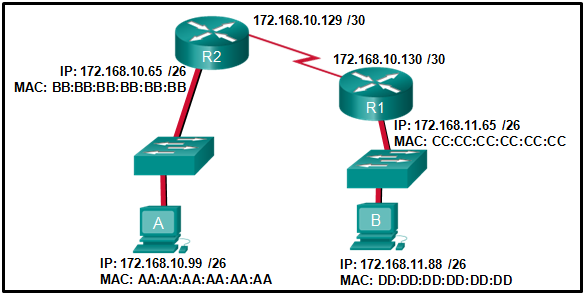CCNA1 v6.0 Chapter 7 Exam Answers
1. How many bits are in an IPv4 address?
32*
64
128
256
2. Which two parts are components of an IPv4 address? (Choose two.)
subnet portion
network portion*
logical portion
host portion*
physical portion
broadcast portion
3. What does the IP address 172.17.4.250/24 represent?
network address
multicast address
host address*
broadcast address
4. What is the purpose of the subnet mask in conjunction with an IP address?
to uniquely identify a host on a network
to identify whether the address is public or private
to determine the subnet to which the host belongs*
to mask the IP address to outsiders
5. What subnet mask is represented by the slash notation /20?
255.255.255.248
255.255.224.0
255.255.240.0*
255.255.255.0
255.255.255.192
6. A message is sent to all hosts on a remote network. Which type of message is it?
limited broadcast
multicast
directed broadcast*
unicast
7. What are three characteristics of multicast transmission? (Choose three.)
The source address of a multicast transmission is in the range of 224.0.0.0 to 224.0.0.255.
A single packet can be sent to a group of hosts.*
Multicast transmission can be used by routers to exchange routing information.*
The range of 224.0.0.0 to 224.0.0.255 is reserved to reach multicast groups on a local network.*
Computers use multicast transmission to request IPv4 addresses.
Multicast messages map lower layer addresses to upper layer addresses.
8. Which three IP addresses are private ? (Choose three.)
10.1.1.1*
172.32.5.2
192.167.10.10
172.16.4.4*
192.168.5.5*
224.6.6.6
9. Which two IPv4 to IPv6 transition techniques manage the interconnection of IPv6 domains? (Choose two.)
trunking
dual stack*
encapsulation
tunneling*
multiplexing
10. Which of these addresses is the shortest abbreviation for the IP address:
3FFE : 1044 : 0000 : 0000 : 00AB : 0000 : 0000 : 0057?
3FFE : 1044 :: AB :: 57
3FFE : 1044 :: 00AB :: 0057
3FFE : 1044 : 0 : 0 : AB :: 57*
3FFE : 1044 : 0 : 0 : 00AB :: 0057
3FFE : 1044 : 0000 : 0000 : 00AB :: 57
3FFE : 1044 : 0000 : 0000 : 00AB :: 0057
11. What type of address is automatically assigned to an interface when IPv6 is enabled on that interface?
global unicast
link-local*
loopback
unique local
12. What are two types of IPv6 unicast addresses? (Choose two.)
multicast
loopback*
link-local*
anycast
broadcast
13. What are three parts of an IPv6 global unicast address? (Choose three.)
an interface ID that is used to identify the local network for a particular host
a global routing prefix that is used to identify the network portion of the address that has been provided by an ISP*
a subnet ID that is used to identify networks inside of the local enterprise site*
a global routing prefix that is used to identify the portion of the network address provided by a local administrator
an interface ID that is used to identify the local host on the network*
14. An administrator wants to configure hosts to automatically assign IPv6 addresses to themselves by the use of Router Advertisement messages, but also to obtain the DNS server address from a DHCPv6 server. Which address assignment method should be configured?
SLAAC
stateless DHCPv6*
stateful DHCPv6
RA and EUI-64
15. Which protocol supports Stateless Address Autoconfiguration (SLAAC) for dynamic assignment of IPv6 addresses to a host?
ARPv6
DHCPv6
ICMPv6*
UDP
16. Which two things can be determined by using the ping command? (Choose two.)
the number of routers between the source and destination device
the IP address of the router nearest the destination device
the average time it takes a packet to reach the destination and for the response to return to the source*
the destination device is reachable through the network*
the average time it takes each router in the path between source and destination to respond
17. What is the purpose of ICMP messages?
to inform routers about network topology changes
to ensure the delivery of an IP packet
to provide feedback of IP packet transmissions*
to monitor the process of a domain name to IP address resolution
18. What is indicated by a successful ping to the ::1 IPv6 address?
The host is cabled properly.
The default gateway address is correctly configured.
All hosts on the local link are available.
The link-local address is correctly configured.
IP is properly installed on the host.*
19. A user is executing a tracert to a remote device. At what point would a router, which is in the path to the destination device, stop forwarding the packet?
when the router receives an ICMP Time Exceeded message
when the RTT value reaches zero
when the host responds with an ICMP Echo Reply message
when the value in the TTL field reaches zero*
when the values of both the Echo Request and Echo Reply messages reach zero
20. What field content is used by ICMPv6 to determine that a packet has expired?
TTL field
CRC field
Hop Limit field*
Time Exceeded field
